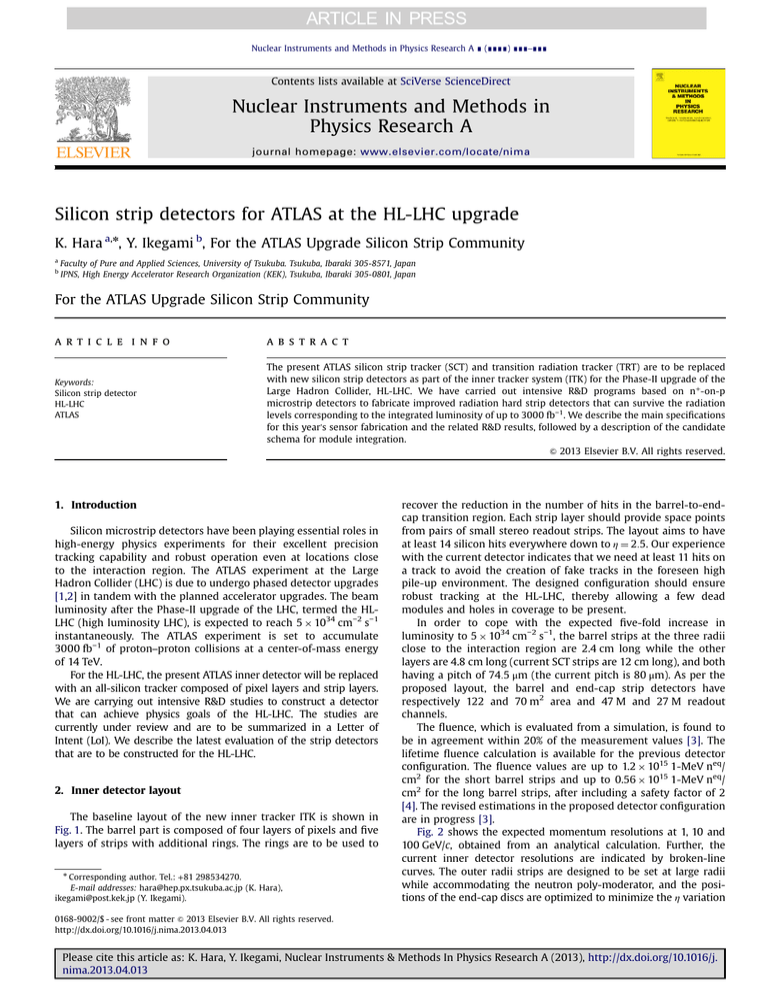
Nuclear Instruments and Methods in Physics Research A ∎ (∎∎∎∎) ∎∎∎–∎∎∎
Contents lists available at SciVerse ScienceDirect
Nuclear Instruments and Methods in
Physics Research A
journal homepage: www.elsevier.com/locate/nima
Silicon strip detectors for ATLAS at the HL-LHC upgrade
K. Hara a,n, Y. Ikegami b, For the ATLAS Upgrade Silicon Strip Community
a
b
Faculty of Pure and Applied Sciences, University of Tsukuba. Tsukuba, Ibaraki 305-8571, Japan
IPNS, High Energy Accelerator Research Organization (KEK), Tsukuba, Ibaraki 305-0801, Japan
For the ATLAS Upgrade Silicon Strip Community
art ic l e i nf o
Keywords:
Silicon strip detector
HL-LHC
ATLAS
a b s t r a c t
The present ATLAS silicon strip tracker (SCT) and transition radiation tracker (TRT) are to be replaced
with new silicon strip detectors as part of the inner tracker system (ITK) for the Phase-II upgrade of the
Large Hadron Collider, HL-LHC. We have carried out intensive R&D programs based on n+-on-p
microstrip detectors to fabricate improved radiation hard strip detectors that can survive the radiation
levels corresponding to the integrated luminosity of up to 3000 fb−1. We describe the main specifications
for this year's sensor fabrication and the related R&D results, followed by a description of the candidate
schema for module integration.
& 2013 Elsevier B.V. All rights reserved.
1. Introduction
Silicon microstrip detectors have been playing essential roles in
high-energy physics experiments for their excellent precision
tracking capability and robust operation even at locations close
to the interaction region. The ATLAS experiment at the Large
Hadron Collider (LHC) is due to undergo phased detector upgrades
[1,2] in tandem with the planned accelerator upgrades. The beam
luminosity after the Phase-II upgrade of the LHC, termed the HLLHC (high luminosity LHC), is expected to reach 5 1034 cm−2 s−1
instantaneously. The ATLAS experiment is set to accumulate
3000 fb−1 of proton–proton collisions at a center-of-mass energy
of 14 TeV.
For the HL-LHC, the present ATLAS inner detector will be replaced
with an all-silicon tracker composed of pixel layers and strip layers.
We are carrying out intensive R&D studies to construct a detector
that can achieve physics goals of the HL-LHC. The studies are
currently under review and are to be summarized in a Letter of
Intent (LoI). We describe the latest evaluation of the strip detectors
that are to be constructed for the HL-LHC.
2. Inner detector layout
The baseline layout of the new inner tracker ITK is shown in
Fig. 1. The barrel part is composed of four layers of pixels and five
layers of strips with additional rings. The rings are to be used to
n
Corresponding author. Tel.: +81 298534270.
E-mail addresses: hara@hep.px.tsukuba.ac.jp (K. Hara),
ikegami@post.kek.jp (Y. Ikegami).
recover the reduction in the number of hits in the barrel-to-endcap transition region. Each strip layer should provide space points
from pairs of small stereo readout strips. The layout aims to have
at least 14 silicon hits everywhere down to η ¼ 2:5. Our experience
with the current detector indicates that we need at least 11 hits on
a track to avoid the creation of fake tracks in the foreseen high
pile-up environment. The designed configuration should ensure
robust tracking at the HL-LHC, thereby allowing a few dead
modules and holes in coverage to be present.
In order to cope with the expected five-fold increase in
luminosity to 5 1034 cm−2 s−1, the barrel strips at the three radii
close to the interaction region are 2.4 cm long while the other
layers are 4.8 cm long (current SCT strips are 12 cm long), and both
having a pitch of 74:5 μm (the current pitch is 80 μm). As per the
proposed layout, the barrel and end-cap strip detectors have
respectively 122 and 70 m2 area and 47 M and 27 M readout
channels.
The fluence, which is evaluated from a simulation, is found to
be in agreement within 20% of the measurement values [3]. The
lifetime fluence calculation is available for the previous detector
configuration. The fluence values are up to 1.2 1015 1-MeV neq/
cm2 for the short barrel strips and up to 0.56 1015 1-MeV neq/
cm2 for the long barrel strips, after including a safety factor of 2
[4]. The revised estimations in the proposed detector configuration
are in progress [3].
Fig. 2 shows the expected momentum resolutions at 1, 10 and
100 GeV/c, obtained from an analytical calculation. Further, the
current inner detector resolutions are indicated by broken-line
curves. The outer radii strips are designed to be set at large radii
while accommodating the neutron poly-moderator, and the positions of the end-cap discs are optimized to minimize the η variation
0168-9002/$ - see front matter & 2013 Elsevier B.V. All rights reserved.
http://dx.doi.org/10.1016/j.nima.2013.04.013
Please cite this article as: K. Hara, Y. Ikegami, Nuclear Instruments & Methods In Physics Research A (2013), http://dx.doi.org/10.1016/j.
nima.2013.04.013i
2
K. Hara, Y. Ikegami / Nuclear Instruments and Methods in Physics Research A ∎ (∎∎∎∎) ∎∎∎–∎∎∎
in resolution; these design changes are estimated to improve the
resolution of the new ITK over that of the current inner detector.
3. Sensor design
The strip sensors are composed of AC-coupled n-type implants
placed in p-type (n+-on-p) float zone (FZ) silicon. This type of
sensor is not subject to radiation induced type inversion, thereby
allowing sensor operation under partial depletion in the case
where the increased full depletion voltage exceeds the maximum
allowed value of the system. The radiation damage is shown to be
moderate because the sensor collects faster electrons and the
strip-related larger weighting fields in the Shockley–Ramo theorem are favored in view of charge collection [5]. The fully
irradiated sensors provide a signal of 7.5–12.5 ke− at 500 V [6]
for various irradiation sources. Since the electronics noise is found
to be less than 700 e− [7,8], the signal-to-noise ratio will remain
above 10.
Fig. 1. Baseline quarter r–z longitudinal view (LoI layout) of new ATLAS inner
tracker (active areas) for HL-LHC.
3.1. ATLAS12
A new sensor design study, named ATLAS12, is programmed in
2012 to address the above issues. The main specifications for the
ATLAS12 sensor are summarized below.
The baseline wafer is a p-type FZ of 4 4 kΩ cm resistivity to
Fig. 2. Estimated pT resolution for different momenta. Dashed curves indicate
resolutions for the current version of ATLAS. Resolutions were obtained using an
analytical calculation.
realize the initial full depletion of o 300 V for a wafer thickness
of 320 μm.
Isolation between strips is achieved by use of a common p-stop
structure with doping concentration of approximately 4 1012
ions/cm2.
The maximum operation voltage is set at 600 V, suitable for
500 V rating of the existing ATLAS cables.
No micro-discharge should occur below 600 V. However, the
sensors will be subjected to test voltage of up to 1 kV to
investigate stable operation at higher biases.
The interstrip capacitance to the nearest-neighbor on both
sides should be 0.8 pF/cm at a 300 V bias with f TEST ¼ 100 kHz.
The allowed strip failure rate is less than 2%.
Fig. 3. ATLAS12 wafer layout for short barrel strip sensor prototypes. (Right) The sensitive area (electrodes running vertically) is segmented into four short strip regions with
the strips in lower two regions tilted with respected to those in upper regions. (Left) Detailed drawings of different zones implemented in the test structures (P1–P24) and of
biasing schema for each segment.
Please cite this article as: K. Hara, Y. Ikegami, Nuclear Instruments & Methods In Physics Research A (2013), http://dx.doi.org/10.1016/j.
nima.2013.04.013i
K. Hara, Y. Ikegami / Nuclear Instruments and Methods in Physics Research A ∎ (∎∎∎∎) ∎∎∎–∎∎∎
The ATLAS12, see Fig. 3 (right), is composed of short strips with
the main sensor which has an area of 97.54 mm2 being segmented
into four segments over the strip length. The strips are biased, see
Fig. 3 (left), from one end via the use of poly-silicon resistors: the
strips in Seg2 and Seg3 share a common bias rail. The strips in the
lower two segments are tilted by 40 Mrad, thereby providing the
possibility of stereo readout when the sensors are assembled backto-back to match the axial and tilted strips. In addition to the main
sensor, miniature sensors with an area of 1 cm2 are manufactured,
and different p-stop structures and strip pitches are examined, see
Fig. 3 (left). The main sensor has a structure denoted as Z4 where
PTP (punch-through protection) is realized by extending the
implant ends closer (20 μm) to the bias rail.
Most of the above mentioned requirements have been already
met in previous production runs [9]. We continue to monitor the
performance of the new prototypes in the light of deeper understanding of the sensor fabrication.
Apart from the more precise values given in the specifications,
which are based on the studies made on the last prototyping
ATLAS07 [10], we remark on two modifications in the mask
design: (1) A second scribe line that provides possibility of
reducing the sensor width (slim edge) and (2) the complete
coverage of the ends of the implants by poly-Si tied to the bias
rails. The second modification enables the stabilization of the
function of PTP of the sensor. The PTP should be designed to sink
as swiftly as possible the large current and to protect the strip
insulator against being damaged by induced large voltage across,
while such large current generation may originate from situations
such as beam splash due to possible accelerator accidents.
3
field width between p-bulk and n-bulk diminishes as the sample
accumulates the fluence. This is because the initial n-bulk has
mutated into p-bulk in the dose range of the investigation. The pbulk (and n-bulk) sensors may require a field width of 450 μm to
withstand the 1000 V bias. These results lead us to introduce a
second scribe line with the width of 450 μm alongside the strips.
Reducing the width of the sensors reduces the material, although the
decision to adopt the second scribe line requires further evaluation.
3.3. PTP structure
The optimum PTP structure has been investigated using
ATLAS07 miniature sensors [12] with emphasis on the structure
3.2. Slim edge
In our design of the sensors, we have set the canonical distance
between the active area to the edge for n-bulk sensors to three
times the sensor thickness to withstand the bias voltage exceeding
the full depletion. We have carried out a systematic measurement
of this distance for Hamamatsu p-bulk sensors with a sensor area
of 4 mm2 [11]. Fig. 4 shows the plot of the field width which can
withstand a 1000 V bias as a function of the fluence when the
sensor is irradiated with 70-MeV protons. The field width is
defined as the distance from the bias ring to the edge while
excluding the implantation. The implantation electrodes are composed of a guard ring of the opposite dopant type as the bulk and a
p-type edge ring. We examined two different sensor thicknesses of
320 μm and 150 μm for both p-bulk and n-bulk sensors.
From the figure, it can be observed that the minimum field width
for a 1000 V bias decreases with the fluence and the difference in
Fig. 4. Fluence dependence of field width for bias up to 1000 V.
Fig. 5. Typical oscilloscope traces when intense laser is spotted near strip end
opposite to PTP structure end while three nearby implant voltages are read out
from end from which laser is spotted. The inset drawing illustrates the test
configuration where the red circle indicates the laser spot, whereas the PTP occurs
at opposite end indicated by arrow. CH1 and CH2 traces are for the two strips
between which the laser was spotted, CH3 is for the strip at neighbor. The laser
trigger pulse is shown in CH4. (For interpretation of the references to color in this
figure caption, the reader is referred to the web version of this article.)
Fig. 6. Maximum voltage of implant as function of generated current. The curves
are shown for different gate coverage fractions over the PTP region; D1 minimum
coverage while D5 indicates full coverage. Samples: test structures with area
of 1 cm2.
Please cite this article as: K. Hara, Y. Ikegami, Nuclear Instruments & Methods In Physics Research A (2013), http://dx.doi.org/10.1016/j.
nima.2013.04.013i
4
K. Hara, Y. Ikegami / Nuclear Instruments and Methods in Physics Research A ∎ (∎∎∎∎) ∎∎∎–∎∎∎
around the strip end. In general, the distance between the strip
end and the bias ring is a key parameter for punch through (PT) to
occur. However, the p-stop adopted to utilize the p-bulk substrate
acts as “PT protector”, thereby complicating the investigation of the
optimum PTP structure [7,8]. Further, our investigation revealed
that another key parameter towards PTP optimization is the gate
structure above the PT region.
The dynamic properties of PTP were studied by injecting an intense
laser beam [13] (1064 nm wavelength with 10 ns duration, focused in
an area 10 μm2 ) at the strip end while measuring the implant voltage
via oscilloscope probes. Typical oscilloscope traces are shown in Fig. 5
where three neighboring implant voltages were read out while one
laser pulse with the generated charge corresponding to passage of 106
charged particles was injected between two of the strips. The
impedance characteristics of the probes can mimic the existence of
the readout ASIC, and hence, the measured voltages can be regarded
as real voltages of the implant when ASICs are connected. However,
this is applicable only when the PT is on, i.e., while the impedance
between the strip to the bias ring is small enough. The implant
voltages increase initially due to the charge generated by the laser
absorption, and subsequently the voltages are dumped due to PTP.
After an interval of about 1:5 μs at the position indicated by the arrow
in the plot, the voltages increase because the PT disappears. The
increase is due to the impedance changes between the strip end and
the bias ring, and the voltages shown cannot be regarded as true
implant voltages.
In fact the PTP characteristics are dependent on the positions of
laser injection and the signal readout. The worst case scenario,
which is illustrated in the figure, occurs when both the laser spot
and readout are at the other end of the PTP structure due to the
existence of a finite implant resistance. The maximum voltages in
this configuration are plotted in Fig. 6 as a function of the laser
intensity. The abscissa represents the current generated by the
laser, with a current of 40 μA corresponding to 106 mips. The
various curves are obtained for different gate coverage fractions
over the PT area, with the gate being controlled via the bias ring
voltage. For the uncovered PTP sample (D1) for which the distance
of strip end and the bias ring is 20 μm, the voltage becomes as high
as that obtained in the absence of a PTP sample for which the
strip-end-to-bias-ring distance is 60 μm. The optimum PTP characteristics are obtained for the gate coverage corresponding to D5
where the PT region is fully covered. In the ATLAS12, the PT
regions are covered by poly-silicon tied to the bias rail.
4. Module design and integration
Fig. 7. Concept of end-cap module in comparison with the barrel stave.
Fig. 8. Shortened version of full stave, “stavelet”. The stavelet width is 12 cm.
The barrel strip detector consists of 512 ladder structures (LS),
as shown in Fig. 7. Each LS has 13 silicon wafers on each side
providing stereo space point reconstruction, where hybrids
equipped with ABC130 ASICs [14], a common interface (EOS) to
the outside and a cooling system are integrated. For 256 channels
per ABC130, 10 chips are lined on a hybrid, collecting signals
alternately from two adjacent sensor rows. Therefore, two (one)
hybrids are required for each wafer comprising short (long) strips.
For the end-caps, the technologies are identical but the sensor
shapes are trapezoidal with six different sensor types being used.
The shortest strips are 2.3 cm long and the longest strips are 6 cm,
with the strip pitch varying from 60 to 110 μm.
The EOS has a gigabit transceiver to interface with the hybrids
along with a fiber optic driver. LV and HV power supplies that
Fig. 9. Concept of super-module frame and prototype of a super-module where eight modules are mounted.
Please cite this article as: K. Hara, Y. Ikegami, Nuclear Instruments & Methods In Physics Research A (2013), http://dx.doi.org/10.1016/j.
nima.2013.04.013i
K. Hara, Y. Ikegami / Nuclear Instruments and Methods in Physics Research A ∎ (∎∎∎∎) ∎∎∎–∎∎∎
connect to the EOS are distributed to each hybrid via a power bus.
The powering is based on either serial power [15] or DC–DC
conversion [16].
The front-end ASIC, which is ABC130 based on 130-nm CMOS
technology, is a binary readout chip providing only hit information
in a manner similar to the functioning of the current SCT ABCD
chip. Following a 256-bit deep L0 buffer cycled at a 40 MHz beam
crossing rate, another 256-bit deep buffer stores the hits of L0
accepted events, allowing a latency as long as 512 μs until L1 or R3
decision is made. In the baseline implementation, the R3 decision
is a Region-of-Interest trigger created by other detectors to request
a certain region of the strip detector to send hit information to aid
the construction an L1 trigger.
Two module integration approaches have been investigated to
construct LSs. The LoI baseline uses a stave approach [8] where
wafers and bus cables underneath are glued onto a light structure
with integrated cooling (see drawing in Fig. 8). The Kapton flex
hybrids are glued directly onto the wafers with electronics-grade
epoxy. The bus cables provide ASIC communication to the EOS
module. The stave is supported sideways as shown in the figure,
which displays a shortened version of a prototype stave constructed using ABC250 chips.
The optional approach is a super-module concept. Two wafers
are glued on both sides of a baseboard, to which the hybrids are
glued so as to bridge over the wafers. A total of 13 such modules
are integrated into a super-module by means of a light-weight
frame to which cooling pipes are attached. The communication is
provided through a bus cable running alongside the module, as
shown in Fig. 9. The figure also shows the photograph of a
prototype super-module [17,7] comprising eight modules.
Mechanical and electrical capabilities of the two designs have
been successfully demonstrated with the use of prototype components. Many of the components such as sensors, front-end
ASICs, and powering schemes are common to both approaches.
The construction of the prototype for end-cap integration,
termed “petal”, that is based on the stave concept, is one of the
major goals to be achieved in this year.
5. Summary
The ATLAS experiment is due to undergo an upgrade involving
the replacement of the inner tracking system to ensure precise
particle tracking in the high-radiation environment expected to be
generated in the HL-LHC. The outer volume of the tracker will be
5
occupied by silicon strip detectors. Sensors produced via n+-on-p
technology have shown excellent performance in this regard,
thereby fulfilling the requested final specifications including radiation hardness. The performance of the new batch of sensors
fabricated this year, the ATLAS12 sensors, continues to be monitored
and documented from the viewpoint of new developments in sensor
fabrication.
A module integration system has been prototyped based on the
stave and super-module concepts, with the practical realization of
both concepts having demonstrated the requested electrical and
mechanical capabilities. Prototyping of the end-cap module integration is in progress.
References
[1] ATLAS Collaboration, Letter of Intent for the Phase-II Upgrade of the ATLAS
Experiment, 2012, CERN-2012-022, LHCC-I-023.
[2] P. Vankov, ATLAS upgrade for the HL-LHC: meeting the challenges of a fivefold increase in collision rate, in: ATL-UPGRADE-PROC-2012-003.
[3] I. Dawson, Radiation background simulation and verification at the LHC and its
upgrades, 2012, in: Presented at VERTEX2012 Workshop, Jeju, Korea, September 16–20, 2012.
[4] S. Baranov, et al., Estimation of radiation background, impact on detectors,
activation and shielding optimization in ATLAS, in: ATL-GEN-2005-001.
[5] G. Kramberger, “Why p-type is better than n-type” or electric field in heavily
irradiated silicon detectors, 2012, in: Presented at VERTEX2012 Workshop,
Jeju, Korea, September 16–20, 2012.
[6] K. Hara, et al., Nuclear Instruments and Methods in Physics Research Section A
636 (2011) S83.
[7] S. Gonzalez-Sevilla, et al., Electrical performance of a silicon micro-strip supermodule prototype for the high-luminosity LHC collider ⟨http://dx.doi.org/10.
1016/j.nima.2012.03.025⟩, 2012.
[8] S. Díez, Silicon strip staves and petals for the ATLAS upgrade tracker of the
HL-LHC, in: ATL-UPGRADE-PROC-2012-002.
[9] J. Bohm, et al., Nuclear Instruments and Methods in Physics Research Section A
636 (2011) S104.
[10] Y. Unno, et al., Nuclear Instruments and Methods in Physics Research Section A
636 (2011) S24.
[11] S. Mitsui, et al., Evaluation of slim-edge, multi-guard, and punch-throughprotection structures before and after proton irradiation ⟨http://dx.doi.org/10.
1016/j.nima.2012.05.071⟩, 2012.
[12] S. Lindgren, et al., Nuclear Instruments and Methods in Physics Research
Section A 636 (2011) S111.
[13] K. Hara, et al., Punch-through protection of microstrip detector against
accelerator beam splash, in: Presented at TIPP11 Symposium, June 9–14,
2011 ⟨http://dx.doi.org/10.1016/j.phpro.2012.02.427 ⟩, 2009.
[14] J. Kaplon, IEEE Transactions 59 (4) (2012) 1611.
[15] J. Matheson, Serial power distribution for the ATLAS tracker upgrade, in: PoS
(RD09) 040.
[16] A. Affolder, et al., DC–DC converters with reduced mass for trackers at the
HL-LHC, in: JINST 6 C11035.
[17] A. Clark, et al., Development of the silicon microstrip super-module prototype
for the HL-LHC ⟨http://dx.doi.org/10.1016/j.nima.2012.04.016 ⟩, 2012.
Please cite this article as: K. Hara, Y. Ikegami, Nuclear Instruments & Methods In Physics Research A (2013), http://dx.doi.org/10.1016/j.
nima.2013.04.013i





